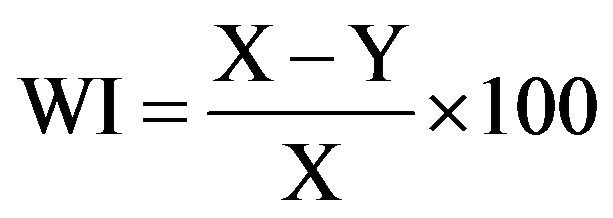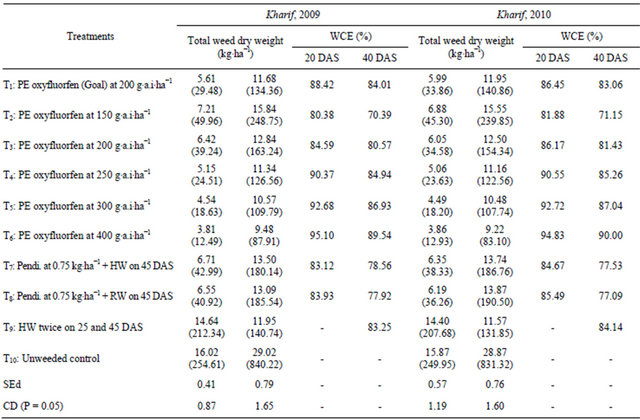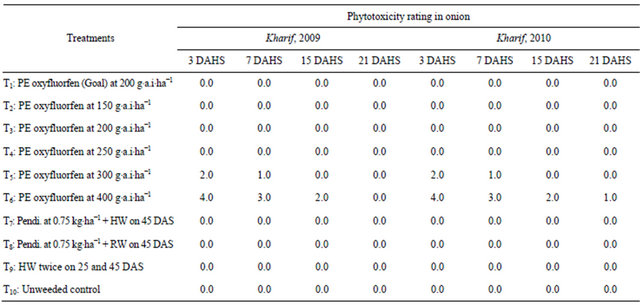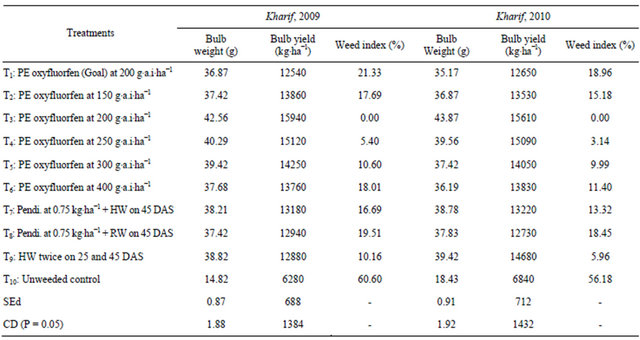American Journal of Plant Sciences
Vol.4 No.4(2013), Article ID:30086,6 pages DOI:10.4236/ajps.2013.44109
Evaluation of New Formulation of Oxyfluorfen (23.5% EC) for Weed Control Efficacy and Bulb Yield in Onion
![]()
Department of Agronomy, Tamil Nadu Agricultural University, Coimbatore, India.
Email: *sathyapriyaagri@gmail.com
Copyright © 2013 Sathya Priya Ramalingam et al. This is an open access article distributed under the Creative Commons Attribution License, which permits unrestricted use, distribution, and reproduction in any medium, provided the original work is properly cited.
Received February 29th, 2013; revised April 1st, 2013; accepted April 11th, 2013
Keywords: Weed Density; Dry Weight; Weed Control Efficiency; Weed Index; Bulb Yield
ABSTRACT
A field experiment were conducted for two years at Agricultural Research Station, Bhavanisagar of Tamil Nadu Agricultural University, during kharif season of 2009 and 2010 to evaluate the new formulation of oxyfluorfen (23.5% EC) on weed control in onion. Weeds constitute one of the biggest problems in agriculture that not only reduce the yield and quality of onion but also utilize essential nutrients. Hence, weed control is essential for increasing onion production. Based on two years field experimentation, it was found that pre-emergence application of oxyfluorfen (23.5% EC) at 400 g∙ha−1 gave significantly lower total weed density, weed dry weight and higher weed control efficiency at all the intervals. Application of new formulation of oxyfluorfen (23.5% EC) at 200 g∙ha−1 as pre-emergence herbicide can keep the weed density and dry weight below the economic threshold level and increase the bulb weight (42.56 and 43.87 g) and yield (15940 and 15610 kg∙ha−1) in onion. Unweeded control accounted for lower bulb yield which inturn reflected through higher weed index of 60.6 and 56.1 per cent, respectively during both the years, due to heavy competition of weeds for nutrients, space and light.
1. Introduction
Onion (Allium cepa var. aggregatum L.) belonging to the family Alliaceae is one of the important bulbous vegetable crop of economic importance and widely cultivated all over the world, with particular distribution in the Asian continent and in Europe. Onion is popularly known as “Queen of kitchen” because of its characterstic flavour. Due to its poor competitive ability with its slow initial growth and lack of adequate foliage makes onion weak against weeds. In addition, their cylindrical upright leaves do not shade the soil to block weed growth. Uncontrolled weed growth reduces the bulb yield upto 40 - 80 per cent depending upon the nature of intensity and duration of weed competition in onion field [1]. Chemical weed control is a better supplement to conventional methods and forms an integral part of the modern crop production. Thus use of herbicides is one of the options left with the farmers to eliminate crop weed competition at early growth stage of crop. The common weed management practice for onion is pre-emergence application of selective herbicides like pendimethalin, oxyfluorfen and oxadiazon followed by one hand weeding. Under chemical method of weed management, the rotation of herbicides is more essential to prevent the weeds to develop resistance to herbicides. Beneath these backdrops, newer formulation of herbicides is coming in the market with wide spectrum of weed control efficiency. The new herbicide formulations are to be evaluated for their bioefficacy of controlling wide range of weed flora, better crop growth and yield of onion. In view of the above facts, an experiment on “Efficiency evaluation of new formulation of oxyfluorfen (23.5% EC) on weed control in onion and their residual effect on succeeding crops” was formulated with the following objectives:
1) To evaluate the bio-efficacy of new formulation of oxyfluorfen (23.5% EC) on weed control in onion;
2) To examine phytotoxic effects of oxfluorfen in onion.
2. Materials and Methods
2.1. Experimental Site and Initial Soil Characteristics
Field experiments were laid out during kharif seasons of 2009 and 2010 in North Block Farm of Agricultural Research Station (ARS) Bhavanisagar, located at Western Zone of Tamil Nadu. The geographical location of the experimental site is 11˚29''N latitude and 77˚08''E longitude with an altitude of 256 m above MSL and the farm receives the normal total annual rainfall of 696 mm in 42 rainy days. The soil of experimental site was well drained red sandy loam in texture (20.19% clay, 9.74% silt, 31.32% fine sand and 38.74% coarse sand) with low in available nitrogen, medium in available phosphorus and high in available potassium. The soil analysed 230.40, 20.20 and 268 kg∙ha−1 of KMnO4-N, Olsen-P and NH4OAc-K, respectively with EC of 0.18 dSm−1, pH of 6.8 and organic carbon of 0.55%.
2.2. Experimental Design, Selection of Cultivar and Sowing
The experiment was laid out in randomized complete block design (RBD) with ten treatments and replicated thrice. The gross plot and net plot size adopted was 30.00 m2 (6.0 m × 5.0 m) and 22.96 m2 (5.6 m × 4.1 m). Small onion (Allium cepa var. aggregatum L.) variety CO 4 maturing in 65 - 70 days suitable for cultivation in Tamil Nadu was used for the study. The onion was sown manually keeping the distance of 22.5 × 10 cm at 1000 kg∙ha−1 of bulb rate during first week of June 2009 and 2010. After sowing the bulb, immediately a light irrigation was given to the crop for uniform germination.
2.3. Treatment Details
Treatments consisted of pre-emergence application of already registered oxyfluorfen (goal) at 200 g∙ha−1, new formulation of oxyfluorfen (23.5% EC) at 150, 200, 250, 300 and 400 g∙ha−1, pendimethalin 0.75 kg∙ha−1 + Hand weeding on 45 DAS, pendimethalin 0.75 kg∙ha−1 + Rotary weeding on 45 DAS, Hand weeding twice on 25 and 45 DAS and unweeded check. The herbicides as per the treatment schedule were applied as pre-emergence at third day after sowing followed by a hand weeding on 45 DAS. Hand operated knapsack sprayer fitted with a flat fan type nozzle (WFN 40) was used for spraying the herbicides adopting a spray volume of 500 litres∙ha−1. For mechanically weeded plots, one weeding was given on 45 DAS with rotary weeder in between rows and the weeds within the rows were removed manually. The recommended dose of 100:150:75 kg∙NPK∙ha−;1 in the form of urea, single super phosphate and muriate of potash were applied to all plots uniformly in lines and fifty per cent of the nitrogen was applied as basal while, the remaining dose was top dressed on 25 DAS and 45 DAS in equal splits. During the course of experiment, the data were recorded on predominant weed flora, weed density and dry weight in onion.
2.4. Observations on Weeds
2.4.1. Weed Density
The weed count was recorded species wise using 0.5 m × 0.5 m quadrat from four randomly fixed places in each plot and the weeds falling within the frames of the quadrat were counted, recorded and the mean values were expressed in number m−2. The density of grasses, sedges and broad leaved weeds and the total weeds were recorded at 20, 40 and 60 days after sowing and expressed in number m−2.
2.4.2. Weed Dry Weight
The weeds falling within the frames of the quadrat were collected, categorised into grasses, sedges and broadleaved weeds, shade dried and later dried in hot-air oven at 80˚C for 72 hrs. The dry weight of grasses, sedges and broadleaved weeds were recorded separately at 20, 40 and 60 days after sowing and expressed in kg∙ha−1.
2.4.3. Weed Control Efficiency
Weed control efficiency (WCE) was calculated as per the procedure [2].

whereWCE—weed control efficiency (per cent);
WDc—weed biomass (g∙m−2) in control plot;
WDt—weed biomass (g∙m−2) in treated plot.
2.4.4. Weed Index
Weed index (WI) was calculated as per the method [3].

where, X = yield (kg∙ha−1) from minimum weed competition plot;
Y = yield (kg∙ha−1) from the treatment plot for which WI is to be worked out.
2.5. Statistical Analysis
The data collected for onion was statistically analysed by following procedure for randomised block design [4]. The data pertaining to weeds and germination were transformed to square root scale of  and analysed [5]. Whenever significant difference existed, critical difference was constructed at five per cent probability level.
and analysed [5]. Whenever significant difference existed, critical difference was constructed at five per cent probability level.
3. Results and Discussion
3.1. Effect on Weeds
Weed flora of the experimental field in onion was predominantly consisted of nine species of broad leaved weeds, five species of grasses and a sedge weed. The dominant grassy weed species were Cynodon dactylon, Acrachne racemosa and Dactyloctenium aegyptium. Among the broad leaved weeds Boerhaavia diffusa, Parthenium hysterophorus and Digeria arvensis were the dominant weeds. Cyperus rotundus was the only sedge present in the experimental field.
3.2. Weed Density
Pre-emergence application of new formulation of oxyfluorfen at 250, 300 and 400 g∙ha−1 followed by one hand weeding on 45 DAS resulted in effective control of broad leaved weeds, grasses and to some extent sedge due to its broad spectrum action (Table 1). Thus, broad leaved weeds were effectively controlled with the herbicide. Pre-emergence application of oxyfluorfen at higher doses of 300 and 400 g∙ha−1 followed by oxyfluorfen at 250 g∙ha−1 gave more impressive control of broad leaved weeds like Boerhaavia diffusa, Parthenium hysterophorus and Digeria arvensis due to the herbicidal effect over cell membrane causing distruption of the cells, ionic balance and ultimately death of weeds [6]. The preemergence application of oxyfluorfen at 240 g∙ha−1 reduced the density of broad leaved weeds (70% to 90%) in onion compared with non treated plots [7]. Application of oxyfluorfen at 400 g∙ha−1 resulted in the weed control of more than 90 per cent of weeds, but the herbicide inhibited the crop growth. Several research findings showed that oxyfluorfen has successfully controlled broad leaved weeds in vegetable systems including broccoli [8], onion [9], chilli pepper [10], cauliflower [11] and cabbage [12]. Pre-emergence application of oxyfluorfen most effectively decreased the number of annual broad leaved weeds in onion and cabbage [13].
3.3. Weed Dry Weight
Weed dry weight is the most important parameter to assess the weed competitiveness for the crop growth and productivity. Sparse weeds with high biomass might be more competitive for crops than dense weeds with lesser dry matter. Considerable reduction in weed dry weight was recorded with the application of oxyfluorfen at 300 and 400 g∙ha−1 at all the stages of observation and it was followed by pre-emergence application of oxyfluorfen at 250 g∙ha−1 and pendimethalin (Table 2). Minimum dry weed biomass was recorded in plots sprayed with pendimethalin while, maximum dry weed biomass was noticed in weedy check, where weeds were not controlled [14]. Weed control efficiency which indicates the comparative magnitude of reduction in weed dry matter, was highly influenced by different weed control treatments. The application of oxyfluorfen, pendimethalin and diuron were evident even after 60 days after sowing as shown by the minimum weed count, weed dry matter production and the maximum weed control efficiency [15]. Throughout the experimental period, weed control efficiency was higher with pre-emergence application of oxyfluorfen at 400 g∙ha−1 followed by oxyfluorfen spray at 250 and 300 g∙ha−1 owing to the fact that it registered lesser weed density and weed dry weight [16].
3.4. Phytotoxicity Effect on Onion
The new formulation of oxyfluorfen at 300 and 400 g∙ha−1 as pre-emergence application showed phytotoxicity symptoms like bleaching, leaf tip burn, leaf curling and also stunting of growth upto 45 DAS in onion (Table 3). The pre-emergence application of oxyfluorfen at 250 g∙ha−1 controlled weeds effectively but resulted in lower yield because of its higher phytotoxicity on onion crop and it was only for a short period [17]. Severity of the symptoms increased in onion with increase in rate of herbicide application and symptoms were visible upto 30 DAS when the herbicide was applied at higher dose of 400 g∙ha−1. The crop injury was transient and appeared stunted for one month, after that the crop appeared normal. The pre-emergence application of oxyfluorfen at 300 to 600 g∙ha−1 resulted in 30 per cent injury in strawberry [18]. The post-emergence application of oxyfluorfen at 150 g∙ha−1 showed phytotoxicity symptoms in pea [19].
3.5. Effect on Crop
During both the years of study, among the weed control treatments, pre-emergence application of oxyfluorfen at 200 g∙ha−1 recorded higher bulb yield of 15,940 and 15,610 kg∙ha−1 due to better control of weeds at critical stages thus providing favourable environment for better growth and development leading to enhanced bulb yield (Table 4). This treatment was comparable with oxyfluorfen at 250 g∙ha−1 with a bulb yield of 15,120 and 15,090 kg∙ha−1 during kharif 2009 and 2010, respectively. Onion productivity is mainly decided by the weed control efficiency of weed management methods. The preemergence herbicides offer the most practical, effective and economical method of weed control for increasing bulb yield of onion [20]. Hand weeding twice on 25 and 45 DAS and application of pendimethalin at 0.75 kg∙ha−1 + HW on 45 DAS was the next best treatment compared to new formulation of oxyfluorfen at 200 and 250 g∙ha−1 and this was recorded higher bulb yield during both the years. Higher bulb yield attributes were recorded with the pre-emergence application of pendimethalin at 0.75 kg∙ha−1 + HW on 45 DAS over already registered oxyfluorfen (goal) at 200 g∙ha−1 applied plots and this might due to weed free environment and effective utilization of all above and below ground available resources. Bulb
Table 1. Effect of different weed management practices on total weed density in onion.

Figures in parenthesis are original values must need for differentiating the original and transformed values; PE: Pre emergence; HW: Hand weeding; Pendi: Pendimethalin.
Table 2. Total weed dry weight and weed control efficiency as influenced by different weed management practices in onion.

Figures in parenthesis are original values must need for differentiating the original and transformed values; PE: Pre emergence; HW: Hand weeding; Pendi: Pendimethalin.
Table 3. Per cent rating of phytotoxic effects in onion.

Data not statistically analysed; PE: Pre emergence; HW: Hand weeding; Pendi: Pendimethalin.
Table 4. Effect of weed management methods on yield and weed index of onion.

PE: Pre emergence; HW: Hand weeding; Pendi: Pendimethalin.
yield reduction in onion is directly related to increasing weed density, dry weight and intensity of weed interference throughout the crop period [21].
Eventhough, the weed control efficiency was higher under application of oxyfluorfen at 300 and 400 g∙ha−1 the bulb yields were lower and the reason might be due to initial phytotoxicity symptoms on onion, which resulted in lesser plant height, leaf area, number of leaves and dry matter production and to end with lower bulb yield. Pre-emergence application of oxyfluorfen at lower doses of 150 g∙ha−1 and oxyfluorfen (goal) at 200 g∙ha−1 registered lower bulb yield when compared to other herbicidal treatments due to poor control of problematic weeds like Cynodon dactylon, Dactyloctenium aegyptium, Cyperus rotundus and Parthenium hysterophorus which showed higher weed density, dry weight and lower weed control efficiency. Under such conditions the crop may not be able to put forth optimum growth due to lack of resources resulting in reduced leaf area, dry matter production and finally recorded lower bulb yield of onion. Unweeded control recorded lesser bulb weight during both the years of study. Among the weed control methods, higher weed index of 21.3 and 18.9 per cent was recorded in pre-emergence application of oxyfluorfen (goal) at 200 g∙ha−1, which might be due to greater competition stress with prolific weed growth and higher nutrient removal by weeds.
4. Conclusion
From the present investigation, it could be concluded that the pre-emergence application of oxyfluorfen (23.5% EC) at 200 g∙ha−1 can keep the weed density and dry weight reasonably at lower level and enhance the productivity of kharif onion resulting in higher economic returns.
REFERENCES
- V. Prakash, A. K. Pandey, R. D. Singh and V. P. Mani, “Integrated Weed Management in Winter Onion (Allium cepa L.) under Mid-Hills Conditions of North-Western Himalayas,” Indian Journal of Agronomy, Vol. 45, No. 4, 2000, pp. 816-821.
- V. S. Mani, M. L. Mala, K. C. Gautam and Bhagavandas, “Weed Killing Chemicals in Potato Cultivation,” Indian Farming, Vol. 23, No. 1, 1973, pp. 17-18.
- G. S. Gill and K. V. Kumar, “Weed Index—A New Method of Reporting Weed Control Trials,” Indian Journal of Agronomy, Vol. 16, 1969, pp. 96-98.
- K. A. Gomez and A. A. Gomez, “Statistical Procedures for Agricultural Research,” Wiley India Pvt. Ltd., New Delhi, 2010.
- G. W. Snedecor and W. G. Cochran, “Statistical Methods,” Oxford and IBH Publ. Co., New Delhi, 1967, p. 593.
- V. S. Rao, “Weed Research Methodology—Field Experimentation,” Principles of Weed Science, Oxford and IBH Publishing Co. Pvt. Ltd, 2000, pp. 497-498.
- N. M. Sukhadia, B. B. Ramani, M. M. Modhwadia and K. B. Asodaria, “Integrated Weed Management in Groundnut (Arachis hypogaea) Wheat (Triticum aestivum) Crop Sequence,” Indian Journal of Agronomy, Vol. 45, No. 2, 2000, pp. 253-256.
- O. Daugovish, S. A. Fennimore and M. Mochizuki, “Integration of oxyfluorfen in strawberry (Fragaria X ananassa) Weed Management Programs,” Weed Technology, Vol. 22, No. 4, 2008, pp. 685-690. doi:10.1614/WT-08-077.1
- B. Aegerter, “Onion Weed Control Research Progress Report,” 2007. http://ucce.ucdavis.edu/file/filelibrary/2019/33585.pdf
- M. D. Amador-Ramirez, F. Mojarro-Davila and R. Velasquez-Valle, “Efficacy and Economics of Weed Control for Dry Chilli Pepper,” Crop Protection, Vol. 26, No. 4, 2007, pp. 677-682. doi:10.1016/j.cropro.2006.06.015
- J. R. Qasem, “Weed Control in Cauliflower (Brassica oleracea var. Botrytis L.) with Herbicides,” Crop Protection, Vol. 26, No. 7, 2007, pp. 1013-1020. doi:10.1016/j.cropro.2006.09.010
- H. M. Hatterman-Valenti and C. P. Auwarter, “Broadleaf Weed Control in Transplanted Cabbage,” Hort Science, Vol. 42, 2007, p. 872.
- W. O. Stall and J. P. Gilreath, “Estimation Effectiveness of Recommended Herbicides on Selected Common Weeds in Florida Vegetables,” In: W. M. Stall, Ed., Weed Management in Florida Fruits and Vegetables, IFAS, Gainesville, 2003, pp. 59-64.
- H. U. Rahman, K. Ullah, M. Sediq, M. Zubari, S. Javaria, M. A. Khan and A. M. Khattak, “Relative Efficacy of Different Weed Control Method in Onion (Allium cepa L.) Crop,” Pakistan Journal of Weed Science Research, Vol. 17, No. 4, 2011, pp. 343-350.
- P. V. Shylaja and C. G. Thomas, “Efficacy of Pre-Emergence Herbicides for Weed Control in Cocoa Seedling Nursery,” Journal of Plantation Crops, Vol. 32, No. 2, 2004, pp. 57-60.
- K. G. Prematilake, R. J. Froud-Williams and P. B. Ekanayake, “Weed Infestation and Tea Growth under Various Weed Management Methods in a Young Tea (Camellia sinensis [L.] Kuntze) Plantation,” Weed Biology and Management, Vol. 4, No. 4, 2004, pp. 239-248. doi:10.1111/j.1445-6664.2004.00144.x
- B. B. Channappagoudar and N. R. Biradar, “Physiological Studies on Weed Control Efficiency in Direct Sown Onion,” Karnataka Journal of Agricultural Science, Vol. 20, No. 2, 2007, pp. 375-376.
- O. Daugovish, S. A. Fennimore and M. Mochizuki, “Integration of Oxyfluorfen in Strawberry (Fragaria X ananassa) Weed Management Programs,” Weed Technology, Vol. 22, No. 4, 2008, pp. 685-690. doi:10.1614/WT-08-077.1
- R. S. Banga, A. Yadav, R. S. Malik and R. K. Malik, “Evaluation of Different Herbicides for Weed Control in Pea (Pisium sativum L.),” Indian Journal of Weed Science, Vol. 30, No. 3-4, 1998, pp. 145-148.
- S. Uygur, R. Gurbuz and F. N. Uygur, “Weeds on Onion Fields and Effects of Some Herbicides on Weeds in Cukurova Region, Turkey,” African Journal of Biotechnology, Vol. 9, No. 42, 2010, pp. 7037-7042.
- J. V. Kathepuri, V. Y. Sankpal, H. L. Ghadage and S. M. Jawale, “Weed Management in Irrigated Onion (Allium cepa L.) under Plane Zone of Western Maharastra,” Madras Agricultural Journal, Vol. 94, No. 1-6, 2007, pp. 127-130.
NOTES
*Corresponding author.

